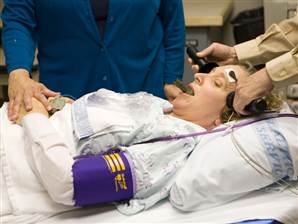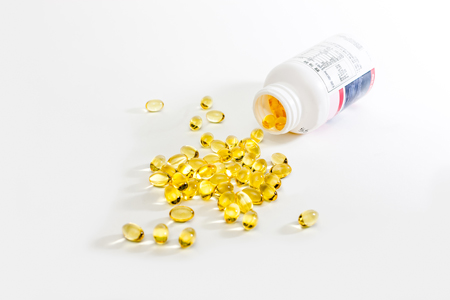Omega-3 Fatty Acids Improve Mood and Limbic Hyperactivity in Youth with Bipolar Depression
Children who have a parent with bipolar disorder are at risk for bipolar illness, but it may first present as depression. Treating these children with antidepressants has the risk of bringing on manic episodes. Researchers are looking for treatment options for youth at risk for bipolar disorder.
Robert McNamara and colleagues found that 12 weeks of omega-3 fatty acids (2,100 mg/day) significantly improved response rates in medication-free youth ages 9–20 years compared to placebo (64% versus 36%). Omega-3 fatty acids but not placebo also reduced the activation of limbic structures in the brain (the left parahippocampal gyrus) in response to emotional stimuli.
Editor’s Note: These data add to the literature on the positive effects of 1–2 grams of omega-3 fatty acids in depression. Given the safety of omega-3 fatty acids and the ambiguous effects of antidepressants in bipolar depression, omega-3 fatty acids would appear to a good alternative, especially since the FDA-approved atypical antipsychotics (quetiapine and lurasidone) are not approved for bipolar depression in people under age 18.
Brain Activity Differentiates Youth with Bipolar Disorder from Youth with Unipolar Depression
Both bipolar disorder and unipolar depression often begin in childhood or adolescence, but it can be difficult to distinguish the two using symptoms only. People with bipolar illness may go a decade without receiving a correct diagnosis. Researcher Jorge Almeida and colleagues recently performed a meta-analysis of previous studies to determine what neural activity is typical of children with bipolar disorder versus children with unipolar depression while processing images of facial emotion. They found that youth with bipolar disorder were more likely to show limbic hyperactivity and cortical hypoactivity during emotional face processing than youth with unipolar depression. Almeida and colleagues hope that this type of data may eventually be used to diagnose these disorders or to measure whether treatment has been successful.
ECT versus Drug Therapy for Bipolar Depression
 Electroconvulsive therapy is often considered a primary treatment option for patients with severe bipolar disorder that has resisted pharmacological treatment. Researcher Helle K. Schoeyen and colleagues recently published the first randomized controlled trial comparing ECT (in this case right unilateral brief pulse ECT) with algorithm-based pharmacological treatment in 76 patients with treatment-resistant bipolar depression.
Electroconvulsive therapy is often considered a primary treatment option for patients with severe bipolar disorder that has resisted pharmacological treatment. Researcher Helle K. Schoeyen and colleagues recently published the first randomized controlled trial comparing ECT (in this case right unilateral brief pulse ECT) with algorithm-based pharmacological treatment in 76 patients with treatment-resistant bipolar depression.
The response rate was significantly higher in the ECT group than in the patients who received drug treatment (73.9% versus 35.0%). However, the two treatment groups had similarly low remission rates (34.8% for ECT and 30.0% for pharmacological treatment).
The algorithm-based pharmacological treatment used in the study was based on a sequence of treatments endorsed by researchers Frederick K. Goodwin and Kay Redfield Jamison in their 2007 book Manic-Depressive Illness. A selected treatment was chosen for each participant based on his or her medical history. If the first treatment was ineffective or intolerable, the patient would be switched to the next treatment option. Antipsychotics, antidepressants, anxiety-reducing drugs, and hypnotics were some of the other treatments included in the algorithms.
Patients in the study had previously showed a lack of response to at least two different antidepressants and/or mood stabilizers with documented efficacy in bipolar disorder (lithium, lamotrigine, quetiapine, or olanzapine) in adequate doses for a period of 6 weeks (or until they quit because of side effects).
Editor’s Note: Even when ECT is effective, there is the issue of how to maintain that good response. We previously reported that in a 2013 study by Axel Nordenskjöld et al. in the Journal of ECT, intensive followup treatment with right unilateral brief pulse ECT combined with pharmacotherapy was more effective than pharmacology alone at preventing relapses. Patients who improved after an acute series of ECT (three times/week) then received weekly ECT for six weeks and every two weeks thereafter, totaling 29 ECT treatments in one year.
Other studies of more intermittent continuation ECT have not proved more effective than medication. Thus high intensity right unilateral brief pulse ECT is one option for extending the effects of successful ECT.
Employment Rights for People with Bipolar Disorder
“Society’s accumulated myths and fears about disability and disease are as handicapping as the…limitations that flow from actual impairment.”
—US Supreme Court
Attorney Katharine Gordon has provided some information on legal rights under the ADA.
When we think of the Americans with Disabilities Act (ADA), we might think of physical modifications to buildings, expensive lawyers, and complicated trials. But this law also gives people with bipolar ways to get fair treatment in the workplace. By learning a bit about your employment rights under this law, you can focus on excelling in your chosen career, rather than being sidetracked by ignorance, stereotypes, and stigma.
Here are a few things that you may not know about bipolar disorder and the ADA:
It is now clear that people with bipolar disorder are protected under the ADA in employment. Prior to 2008, there was often a battle of the experts to prove that a person with bipolar disorder had a severe enough impairment to be protected. This discouraged many from asking for their rights to be respected under this law in the first place. Unfortunately, companies would fire people for having bipolar disorder and then, in next breath, argue that bipolar wasn’t a real disability therefore it was legal to fire people for reasons related to their bipolar disorder.
This changed with the passage of the Americans with Disabilities Act Amendments Act of 2008, which made it easier to establish disability. The Equal Employment Opportunity Commission, the agency responsible for enforcing this law, has made it clear in official regulations that bipolar should generally be covered as a disability for the purposes of protection in employment: “It should easily be concluded that the following types of impairments will, at a minimum, substantially limit the major life activities indicated:…major depressive disorder, bipolar disorder, post-traumatic stress disorder, obsessive compulsive disorder, and schizophrenia substantially limit brain function.” 29 C.F.R. § 1630.2(j)(3)(ii), (iii).
Job applicants should never be asked whether they have bipolar disorder (or any other disability) until a conditional offer has been made. Read more
More Data on Memantine for Treatment-Resistant Depression
In 2012 we reported on an open study by Athanasios Koukopoulos and colleagues that explored whether the NMDA glutamate receptor antagonist memantine (Namenda), which is used to treat dementia, could be helpful to people with treatment-resistant bipolar disorder. In an update of that study, the researchers, led by Giulia Serra, compared patients’ symptoms during three years of treatment as usual, followed by three years with memantine added to their stable medication regime (at doses of 20–30 mg/day). Patients improved progressively over the three years of taking memantine.
Improvements in symptoms included decreased time ill, decreased severity of symptoms, decreased duration of new episodes, and fewer episodes per year. Memantine was particularly helpful for those patients who had had rapid or continuous cycling. Side effects were minimal.
Given the success of this open study, randomized controlled trials are needed to explore this much-needed option for people with treatment-resistant bipolar disorder.
Keith O’Neil: A Football and Public Health Hero
 Keith O’Neil is a former Super Bowl champion and the founder of the Forever Foundation, an organization whose mission is to educate the public about bipolar disorder and to de-stigmatize the illness. In September he spoke at the Brain and Behavior Research Foundation (formerly NARSAD) meeting in Washington, DC.
Keith O’Neil is a former Super Bowl champion and the founder of the Forever Foundation, an organization whose mission is to educate the public about bipolar disorder and to de-stigmatize the illness. In September he spoke at the Brain and Behavior Research Foundation (formerly NARSAD) meeting in Washington, DC.
O’Neil’s life story holds many important lessons— not only about the difficulties of bipolar illness, but also about the hope of recovery. He described being six years old and experiencing high levels of anxiety and fear, and an inability to get to sleep. His mind raced and he was so irritable that he was nicknamed “The Bear.”
The anxiety and the racing thoughts continued, and O’Neil became increasingly depressed. When he was 10 or 12 years old, he began to experience suicidal thoughts and searched his parents’ medicine cabinet for pills he could use to commit suicide. Anxiety and depression became more prominent even though he was an “A” student, one of the most popular kids at school, and an extraordinary athlete, and had a loving family and many friends. He began to use alcohol excessively, had conduct problems, was impulsive and was always in trouble.
O’Neil excelled in football in high school, started college at Northern Arizona University, and quickly became an All-American linebacker at Penn State. He was a first-round draft pick for the New York Giants. His teammates would nap between workouts for coach Bill Parcells, but instead, O’Neil would sit and cry over his inability to sleep. When he was later picked up by the Dallas Cowboys as a free agent, he was unable to sleep for five nights.
O’Neil moved on to the Indianapolis Colts. He did not sleep for four nights before his first game, and told coach Tony Dungy that he needed help, as he did not think he could play the next day. Dungy took him seriously and had him meet with the general manager, the team doctor, and the trainer. O’Neil felt extraordinarily relieved to be able to talk about his anxiety for the first time and took some clonazepam (Klonopin) for sleep and anxiety. Although he missed his first game, he became increasingly successful and the captain of the team that three years later would go on to win the Super Bowl.
O’Neil returned to the Giants for five seasons. While in New York, his wife miscarried, triggering O’Neil’s first major manic episode. He felt super human, spent excessive amounts of money (bought a Rolex watch and three diamond earrings), did not need sleep, and was generally out of control. In 2010, O’Neil was diagnosed with bipolar disorder by Steven Dubovsky, one of the pioneers in the development of calcium channel blockers for the treatment of bipolar disorder.
After his manic episode, O’Neil swung into a severe 18 month–long depression, which he described as “the depths of hell.” He gradually improved and started on a regimen that included medications, exercise, and relying on his family for comfort and support. He then moved to Phoenix, Arizona to start his foundation—the Forever Foundation.
The foundation provides information about the illness and promotes de-stigmatization. O’Neil visits high schools to teach students about bipolar illness and the importance of talking about anxiety and depression and getting help.
In the question and answer period following his talk, O’Neil discussed his own treatment. His early experiences with antidepressants were somewhat positive for his depression and anxiety, but may have been influential in his first manic episode. He said he is now well, and described his current medication regimen, which includes lithium, the mood stabilizing anticonvulsant oxcarbazepine (called Trileptal, which is structurally similar to carbamazepine or Tegretol), and the atypical antipsychotic aripiprazole (Abilify), which works extraordinarily well for him and which he called his savior. O’Neil occasionally uses Ambien (zolpidem) or Seroquel (quetiapine) for sleep.
O’Neil talked about the importance of confronting his own illness and adopting a positive attitude about getting treatment and doing everything he could to get well. He had a family history of mood disorders including depression in his paternal grandfather and bipolar disorder in an uncle.
O’Neil remembered that in his days as a professional football player, even though he was a standout player, he was so anxious that he would get confused about the playbook and have to rehearse it over and over in order to remember. He felt that he dealt with his racing mind and his anxiety in part by funneling it into “controlled recklessness” as a football player.
Keith O’Neil received a standing ovation from the gathering of scientists and approximately 150 supporters of the Brain and Behavior Research Foundation .
It is noteworthy that after Keith’s presentation, many of the scientific presenters speaking about the latest advances in the understanding and treatment of anxiety disorders in children, depression, and bipolar disorder directly referred to his life story and the important messages embedded in it. Read more
Psychotherapy of Childhood Bipolar Disorder
At the 2014 meeting of the American Academy of Child and Adolescent Psychiatry, there was an excellent symposium on different psychotherapeutic approaches for children and adolescents with bipolar disorder and related illnesses.
Amy West of the university of Illinois at Chicago started off this symposium by describing the effectiveness of child-and family-focused cognitive-behavior therapy or what is sometimes called RAINBOW therapy. Rainbow stands for Routine, Affect regulation, I can do it, No negative thinking, Be a good friend and balance life stressors, Oh how can we solve problems, and Ways to find support.
West emphasized the importance of routine in sleep, diet, medications, and homework, and indicated that frequent soothing is necessary. Posted reminders are also helpful.
Affect regulation can be encouraged by promoting coping skills, particularly around identifying what triggers mood swings and rage attacks and creating plans for dealing with them.
“I can do it” reminds parents and children to focus on strengths, successes, positive feedback, and the ability to call for help.
“No negative thinking” encourages positive restructuring and reframing of negative perspectives. Part of this includes mindfulness training for children and parents, who are taught to focus on breathing and accepting thoughts and emotions.
Being a good friend focuses on listening, engaging friends, and enhancing communication.
“Oh how can we solve problems” reminds families to have an attitude of problem solving.
Remembering ways to find support reminds parents to connect with relevant resources, and also coaches parents to be advocates for their children.
In a randomized study of 12 sessions of child and family focused cognitive behavior therapy, the children did much better than those receiving treatment as usual and showed greater improvement in mania and depression as well as overall functioning.
The second presentation was given by Mary Fristad of Ohio State University. She treated children with bipolar disorder not otherwise specified (BP-NOS) with psychotherapy and omega-3 fatty acids. Some research had suggested the efficacy of omega-3 fatty acids in childhood mood disorders and a much larger literature was positive in adult mood disorders. Given the safety of the manipulation, she felt it was worth trying in young children and those with BP-NOS who are rarely studied formally. She also cited a 2010 study by Amminger et al. in children who were at ultra high risk for schizophrenia. In that study, patients were randomized to 12 weeks of omega-3 fatty acids or placebo, and omega-3 fatty acids were associated with a very low conversion rate to full-blown psychosis, 4.9%, compared to 27.5% for those receiving placebo. Fristad’s psychotherapy also emphasized education, support, and skill building in order to enhance understanding of the illness and its treatment. This would help ensure better compliance and better treatment outcome. Her formal treatment manual is available at www.moodychildtherapy.com.
Fristad randomized children with bipolar not otherwise specified, average age 10.2 +/- 0.2 years to either her psychotherapy plus omega-3 fatty acids or therapy plus placebo. Therapy plus omega-3 was much more effective on most outcome measures.
Editor’s Note: Given the safety of omega-3 fatty acids, even these limited data would appear to justify their use in children with BP-NOS in the context of psychotherapy and psychoeducation.
The third presenter was David Miklowitz of UCLA who discussed family focused therapy. This approach has proven effective in studies of both adults and adolescents with bipolar disorder, and as well for those with prodromal symptoms. Read more
Inflammation is Associated with Cognitive Dysfunction in Children with Bipolar Disorder
Researcher Ben Goldstein reported at the 2014 meeting of the American Academy of Child and Adolescent Psychiatry that children with bipolar disorder have levels of inflammatory markers in the same range as people with inflammatory illnesses, such as rheumatoid arthritis. In his research, increases in the inflammatory marker c-reactive protein (CRP) occurred in proportion to the severity of manic symptoms in the children.
Goldstein also discussed cognitive dysfunction, which is often seen early in the course of childhood onset bipolar disorder. Goldstein described studies showing that this type of cognitive dysfunction consists of a decrease in reversal learning, a measure of cognitive flexibility. Elevated CRP was significantly associated with deficits in a child’s composite score for reversal learning.
Together these data suggest that inflammation could play a role in disease disability and cognitive dysfunction in childhood bipolar disorder.
More Evidence That Lithium Prevents Mania and Depressions
There is a large body of research showing that lithium is better than placebo and a variety of comparison drugs at preventing manic episodes in people with bipolar disorder. It has been less clear whether lithium is as effective in preventing depressions in bipolar patients. In a 2014 meta-analysis in the International Journal of Bipolar Disorders, Emanuel Severus and colleagues confirmed that lithium was more effective than placebo at preventing mood episodes overall and manic episodes. In a fixed effect statistical analysis, lithium was also better at preventing depressive episodes.
The portion of the meta-analysis comparing lithium to placebo included seven randomized controlled trials that included a total of 1,580 patients. Lithium was more likely than placebo to lead to patients dropping out of a study for reasons other than a mood episode, but patients who received lithium were more likely to complete their clinical trials.
Another part of the meta-analysis compared lithium to anticonvulsant drugs. Seven trials were included totaling 1,305 patients. Lithium was better than anticonvulsants at preventing manic episodes, but equally effective at preventing mood episodes overall and depressive episodes specifically. There was also no difference in patients dropping out of the trials or completing the trials.
The researchers concluded that lithium remains the most valuable treatment option for bipolar disorder, because no other drug has such consistent efficacy in preventing manias and depressions and mood episodes in general.
Risk of Bipolar Disorder Associated with Enhanced Verbal Ability and Positive Social Traits
A recent twin study suggests that the genes that confer risk for bipolar disorder may also be associated with verbal ability and sociability. Considerable evidence has suggested that people with bipolar disorder have greater intelligence and creativity than the normal population. Positive qualities like these may make people with bipolar disorder attractive mates, leading to the continued propagation of genes that promote bipolar disorder. (One might expect lower than normal rates of reproduction in people with bipolar disorder due to the difficulties the illness creates, as occurs with schizophrenia, but people with bipolar disorder have normal rates of reproduction, suggesting that any obstacles to mating are balanced by other particularly attractive qualities.)
Researchers led by Rachel G. Higier used a Swedish registry of twins to investigate whether people with bipolar disorder and their fraternal or identical twins without the illness have better verbal ability and sociability. Bipolar patients and their twins (who would be expected to have similar genetic and familial risks but without the negative impact of the illness and medications for it) were compared to patients with schizophrenia and their twins and normal controls. The well twins of bipolar patients scored higher on a scale of positive temperament than the bipolar patients, schizophrenia patients and their twins, and controls. The twins of bipolar patients also scored better than schizophrenia patients and their twins and controls on tests of verbal learning and fluency, while the bipolar patients showed lower levels of cognitive function (likely due to their illness).
The researchers conclude that the genes that put families at risk for bipolar disorder also confer positive traits like verbal ability and positive temperament that make people with bipolar disorder attractive mates. Even though bipolar disorder may reduce these traits somewhat, people with the illness still are more creative than the general population and often very successful.









